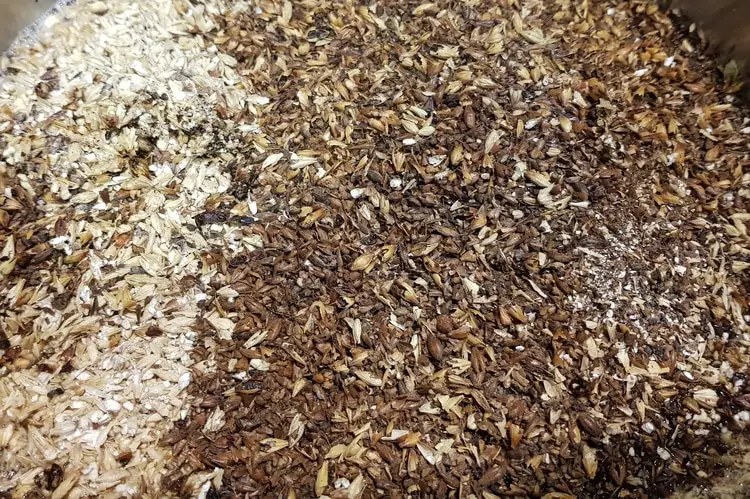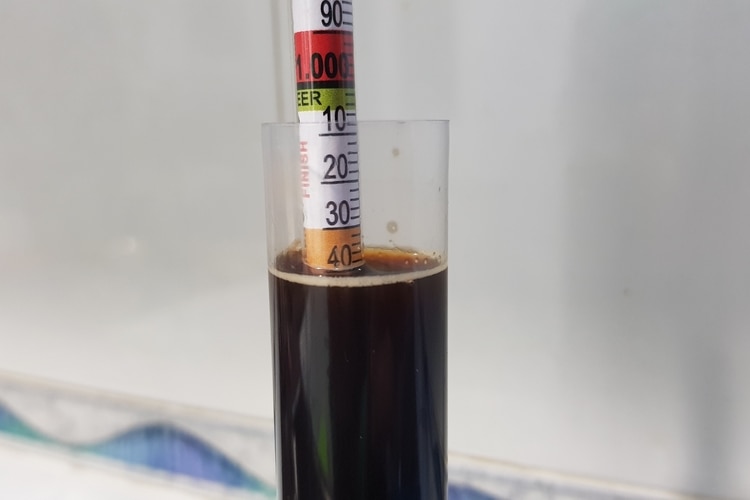Gentlemen, ladies, I’m here to tell you, DON’T PANIC! Thank you, Mr. Adams. Sometimes our FG ends up higher than we’d planned. If brewing strong beer, maybe OK. If brewing a session beer 4 – 5%, maybe trouble in paradise.
The primary causes of high final gravities (FG) are dark malt extracts, an adjunct ingredient, sluggish yeast, mash issues, or low fermentation temperatures. The yeast often cannot perform, nor had the proper sugars to convert. High FGs will occur unexpectedly.
To follow I’ll review several main culprits causing high FG. Some are perfectly natural, others are a bit more complicated. I’ll address them in order of difficulty.
1) High Malt Extract Content
In the beginning, there was DME (dried malt extract) or his brother, LME (liquid malt extract).
Nearly all brewers begin here.
Malt extract is mashed malt converted to wort and then boiled down into a concentrated form.
Much like maple syrup, people may not realize that syrup is only 10% of the volume of Maple sap. So it is with beer wort, generally speaking.
If making an amber or dark beer with extract, there is a limit to what the terminal gravity can be.
Extract is produced in a special vessel, an evaporator, that in essence boils the malt at a very low temperature to keep it from scorching.
That said, it undergoes kettle browning, also known as the Maillard effect. Compounds called melanoidins form giving the malt not just the color, but the toasty, baked flavor.
It’s the same exact process that occurs when baking. The browning flavor, the crust contains melanoidins.
How does this affect us?
Well, melanoidins are unfermentable, and dark DME or LME will be high in them.
So, a low FG for these beers could be in the 1.016 – 1.018 range.
If the OG was only 1.046 – 1.048, it may be a tasty beer, but will be decidedly mild, perhaps 4% ABV.
2) Cool temperatures
Spring and fall are excellent times to brew. As I did much of my brewing outside on a propane burner, it’s like a Saturday picnic, except less food, and lots more beer! I lived in the NC mountains. As South as we are, the Appalachians can be much cooler than the flatlands.
If fermenting beer dips down to about 60˚ F (15° C) one chilly evening and doesn’t have time to heat back up, the beer can stall out. Fermentation slows considerably or just stops.
Solutions
Make sure the yeast is pitched at 64-66˚ F (17-18° C) and wrap the vessel in a blanket until it takes off. If the ambient temp is a bit cooler, that’s ok as the beer will produce heat and remain stable until primary fermentation is complete. Normally, beer could heat up 2-4˚ F during fermentation but if it is cooler, it may not.
If pitched at 60 – 62° F (15 – 16° C), there could be a sluggish start and the yeast just won’t finish. If this happens, take a gravity reading. If it is too high, try to place the beer where it will heat back up. The yeast can reanimate. Much more about correcting cool beer temps can be checked at, How Do You Brew Beer in Cold Weather.
3) Adjunct Malts and Ingredients

As with dark extracts, the same can occur in beers with high amounts of dark or highly kilned malts.
Bocks for example use a high percentage of Munich Malt, a light to moderately kilned flavored malt, adding an extraordinary toast or breadiness to the beer.
Once at the French Broad Brewery, a brewery I opened, I took it into my head to brew a Bock beer with all Munich Malt; no pale malt at all.
I called Briess Malt, the reputable Wisconsin Maltster I’d always worked with and asked, “can I mash Munich malt using a single-temp infusion mash?”.
That is, I would not step-mash, trying to mash at different temperatures, in stages, as most German styles require.
They said, and I condense for clarity, “Sure, go ahead.”
It was my first Bock, so the OG was only about 1.054.
“OK, no problem, It’ll ferment down to 1.012 or so, BOOM, strong Bock beer.”
The FG was 1.020. It tasted good.
German lager yeast, German Perle and Hallertau hops, and 3.6% alcohol, in a bock.
Damn it!
4) High Mash Temp
To compound the struggle, I was shooting for a high mash temp, about 156 – 158˚°F (68 – 70° C).
This will make a full-bodied beer.
It produces extra dextrins, unfermentable proteins giving it big mouthfeel.
I thought at first that I scorched the mash.
I struck too high at about 174˚ F (78° C) and it stayed at 159˚ F (70° C) for a bit.
Doom and gloom, I ranted and raved, how could I screw this up?
I called John Lyda, a local brewer and friend, who happened to be driving through.
He said, “You got any iodine?” “Oh yeah, I forgot about that.” I tested it, full conversion.
I’d been losing my head for 30 minutes already.
In this case, I had to live with it.
I mashed with 100% specialty malt.
I didn’t have the fermentables or likely proper pH to achieve a lower FG.
We drank the beer, I adjusted, and subsequent batches were better.
Solution
Use at least 60% pale malt for any base brew.
Adding 38% Munich 20L and 2% Chocolate Malt will give the profile a bock needs. The pale malt holds all the enzymes needed to convert fully. Most beers need no more than 20 – 25% specialty malts at most.
Also, mash at a lower temp, what I call the bridge temp: 153 – 154˚ F (67° C).
Here the beta and alpha enzymes are activated, and if it does drop below 152˚ F (66° C) deactivating the alpha, the beta is still going strong.
There are more fermentables available for the yeast and less chances of stalled fermentation.
5) Underpitched yeast – General yeast issues
Old yeast, under-pitching, or suboptimal fermentation temps can all cause fermentation problems, leading to high FGs.
These days, the quality and quantity of pitchable liquid yeast cultures make yeast handling a pleasure and the beer quality light-years ahead of that brewed by old sons-of-biscuit eaters like me.
Always hydrate dry yeast, or the beer could start slowly.
The yeast may be old, or as recounted above simply be too chilly.
Try to warm it up if you can.

However, yeast problems are something one needs to solve proactively.
Be ready for the problem before it occurs.
Pitching too hot is an issue also. Yeast will take off like a scalded dog, as my granddad used to say.
Long story short, the dog is fine now, however, the beer goes crazy for 48 hours and then dies, nothing, not even a sporadic, BLURP.
Solutions
Yeast must be pitched within the proper window, 60 – 66˚° F (15 – 19° C) is best.
Too low and it will not multiply properly.
Too high and it will overmultiply, create off-flavors and be shocked into submission.
There are commercial yeast nutrients available like this one on Amazon.
Use a little bit when pitching.
It could be used to reactivate yeast that has prematurely slumbered, though to less effect.
There is a wealth of info about yeast in the articles, Dry Yeast vs Liquid Yeast: Which One to Use for Homebrewing or Consequences of Overpitching and Underpitching Yeast.
Should I re-ferment beer with a high FG?
Once beer has stalled, yeast flocculated, it may be hard to rouse it. Adding yeast will likely not help unless it is an active slurry from another beer. It must currently be working in an anaerobic state to have an effect.
If pitching fresh yeast into an oxygen-free environment, it cannot grow and function.
Again, I emphasize the vital importance of proper yeast handling.
How do I lower my final gravity now?
- If the beer cools, get it heated back up to 65 – 68˚° F (18 – 20° C).
- Add a yeast nutrient if stuck.
- Attempt to add active slurry or fermenting wort from another beer.
- You could blend the beer with another complimentary batch, already in secondary.
How do I make sure to reach my final gravity next time?
- Use more light malt extract in the recipe
- Always use at least 60% base malt in the recipe: keep specialty malts under control, in most cases not more than 20%
- Mash between 149 – 153˚ F (65 – 67° C).
- Use yeast nutrient at pitching.
- Brew the same beer, really dry this one out, blend the two.
FG too high: not everything is lost
Most of these solutions are preventative.
There are also a few to try once you get stuck.
Once your beer has started, the options are limited. If things go south on you, look back through your notes, make adjustments and keep moving forward.
It not only makes us better brewers but gives us adaptability and resilience that helps us with many more things than just beer

